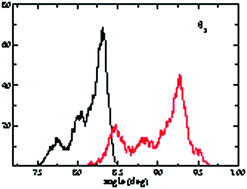Thermal compaction of the intrinsically disordered protein tau: entropic, structural, and hydrophobic factors†
Abstract
Globular denatured proteins have structural properties similar to those of random coils. Experiments on denatured proteins have shown that when the temperature is increased thermal compaction may take place, resulting in a reduction of their radius of gyration Rg to range between 5% and 35% of its initial value. This phenomenon has been attributed to various causes, namely entropic, hydrophobic, and structural factors. The intrinsically disordered protein tau, which helps in nucleating and stabilizing microtubules in the axons of the neurons, also undergoes a relevant compaction process: when its temperature is increased from 293 K to 333 K its gyration radius decreases by 18%. We have performed an atomistic simulation of this molecule, at the lowest and highest temperatures of the mentioned interval, using both standard molecular dynamics and metadynamics, in parallel with small-angle X-ray scattering experiments. Using the fit of the experimental data and a genetic algorithm to select the most probable configurations among those produced in both atomistic simulations (standard MD and metadynamics), we were able to compute relevant changes, related to the temperature increase, in the average angles between residues, in the transient secondary structures, in the solvent accessible surface area, and in the number of intramolecular H-bonds. The analysis of the data showed how to decompose the compaction phenomenon into three contributions. An estimate of the entropic contribution to the compaction was obtained using the changes in the mean values of the angles between contiguous residues. The computation of the solvent accessible surface at the two temperatures allowed an estimation of the second factor contributing to the compaction, namely the increase in the hydrophobic interaction. We also measured the change in the average number of residues temporarily being in α-helices, 3-helices, PP II helices, β-sheets and β-turns. Those changes in the secondary structure population produce a reduction in the contour length of the protein, yielding a structural contribution to the reduction of Rg. This analysis shows that in tau the entropic factor accounts for about 60% of the compaction, the hydrophobic factor for about 25%, and the change in the secondary structure for about 15%.



 Please wait while we load your content...
Please wait while we load your content...